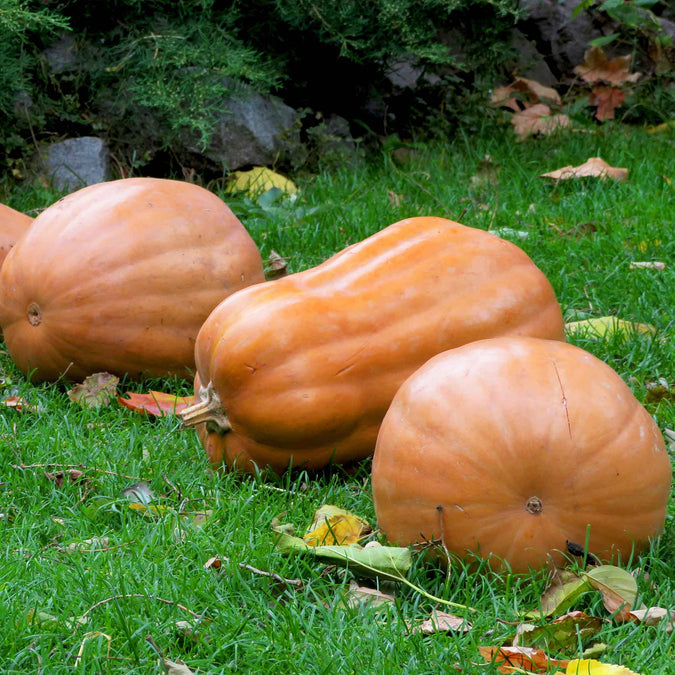
Dharaseeds
Pumpkin Seeds Kentucky Field for planting in southern vegetable patch and large pumpkin bed
Estimated Free Delivery between April 19 and April 22.
Secured Payment Methods
Your transaction is protected with advanced security measures to keep your information confidential
The Kentucky Field pumpkin is a traditional variety known for its robust growing habit and large, round shape. This pumpkin is an ideal choice for those looking for a versatile, all-purpose pumpkin for both decoration and culinary uses. With its deep orange color and slightly ribbed skin, Kentucky Field pumpkins are perfect for fall harvest displays, as well as baking and cooking.
Key Benefits
- All-Purpose Variety: The Kentucky Field pumpkin is perfect for a wide range of uses, from carving and decorating to cooking and baking.
- Large, Robust Fruit: This variety produces large pumpkins, typically ranging from 12–20 pounds, making them ideal for carving or creating a standout fall centerpiece.
- Sweet, Tender Flesh: The flesh of the Kentucky Field pumpkin is firm and sweet, making it great for pies, soups, and other pumpkin-based dishes.
- High Yield: Known for producing high yields of large pumpkins per plant, Kentucky Field is an excellent choice for home gardeners looking for abundant harvests.
Variety Features
- Plant Characteristics: Kentucky Field pumpkins are vigorous, sprawling vines that can grow extensively, producing multiple pumpkins per plant.
- Fruit Profile: The pumpkins have a classic round shape with slightly ribbed, deep orange skin. The flesh is sweet and perfect for cooking.
- Maturity: This variety reaches maturity in 100–120 days from planting, making it an excellent choice for those who have a longer growing season.
Planting Instructions
Planting Season
- Plant Kentucky Field pumpkin seeds after the last frost date when the soil temperature reaches about 70°F (21°C). For regions with shorter growing seasons, start seeds indoors 2–3 weeks before the last frost date.
Planting Details
- Seed Depth: Sow seeds 1–1.5 inches deep in well-draining soil.
- Spacing: Space the seeds 36–48 inches apart to allow the vines ample room to spread.
- Soil Requirements: Pumpkins thrive in rich, well-draining soil with a pH of 6.0–7.0. Adding compost or well-rotted manure will enhance soil fertility.
Care Instructions
Watering
- Keep the soil consistently moist, especially during fruit development. Water at the base of the plant to prevent wetting the leaves, which can lead to fungal diseases.
- Water deeply to ensure the plant has access to moisture during dry spells.
Fertilization
- Apply a balanced fertilizer at planting, followed by a high-phosphorus and potassium fertilizer once flowering and fruit development begin to ensure healthy growth and fruit production.
- Organic compost can be added periodically to provide nutrients.
Weeding and Mulching
- Mulch around the plants to retain moisture, keep the soil temperature stable, and suppress weeds.
- Weeding regularly will help prevent competition for nutrients.
Pest and Disease Control
- Watch out for common pumpkin pests, including aphids, squash bugs, and cucumber beetles. Insecticidal soap or neem oil can help manage these pests.
- Avoid overhead watering and ensure good air circulation around the plants to reduce the risk of fungal diseases like powdery mildew.
Harvesting
When to Harvest
- Kentucky Field pumpkins are ready to harvest when their skin is fully orange and firm to the touch. The stem should also be dry and tough when the pumpkin is mature.
- Harvest typically occurs 100–120 days after planting, usually in mid to late fall.
How to Harvest
- Use a sharp knife or pruning shears to cut the pumpkin from the vine, leaving about 2 inches of stem attached to the fruit. Handle the pumpkins carefully to avoid bruising or damaging the skin.
Storage
- Storage Conditions: Store harvested pumpkins in a cool, dry, and well-ventilated area. When stored properly, Kentucky Field pumpkins can last for 1–3 months.
- Curing: Cure the pumpkins by placing them in a warm, dry area for 10–14 days to allow the skin to harden and enhance their storage life.
Culinary Uses
- Pumpkin Pie: Kentucky Field pumpkins are perfect for making delicious, sweet pies with a rich, creamy filling.
- Soups and Stews: Use the tender flesh in hearty soups and stews for a comforting fall meal.
- Roasting: Slice and roast for a savory side dish or salad topping.
- Baked Goods: Puree the flesh and add it to baked goods like muffins, cakes, and breads for a natural sweetness and moisture.
Conclusion
The Kentucky Field pumpkin is a classic, versatile variety that brings beauty and utility to any garden. Its large size, vibrant color, and sweet, flavorful flesh make it a great choice for both decoration and culinary use. Whether you're carving pumpkins for Halloween or baking a fall-inspired pie, the Kentucky Field pumpkin will deliver abundant harvests and exceptional flavor.









